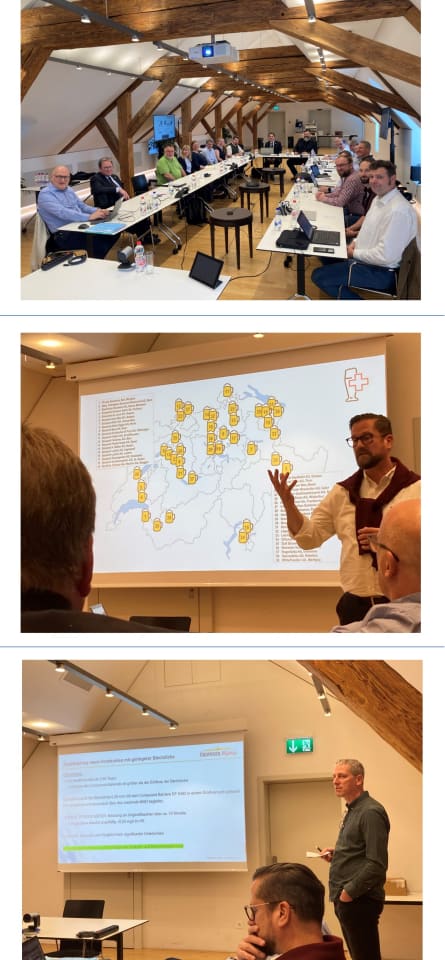We look back on a successful and labour-intensive 102nd MEBAK meeting and would like to thank Labor Veritas AG and the Swiss Brewery Association for the invitation and the great organisation!
On the previous day, the working groups were able to exchange information on their topics internally and discuss the latest methods and updates, before many honorary members were also welcomed to Bern for the welcome evening. In addition to association matters and reports from the various MEBAK departments, the agenda for the plenary session also included goals and tasks for the near future, such as more intensive coordination with other analysis committees.
All working groups, including the Online, Raw Materials, Hops, WüBiMi, Microbiology, Water, GUP, Krüger-Anger and Sensor Technology working groups, reported on their progress and upcoming updates. These are constantly being added to the methods on the website and listed in a brief overview.
Admission of Mr Dipl.-Braumeister Robert Jell
It was unanimously decided to accept the new member Mr Robert Jell, a master brewer. With his very informative presentation on the subject of ‘Qualification of new crown corks with thinner sheet thickness’, he gave all members a deeper understanding of the quality criteria of crown corks and their influence on beer quality. This was impressively demonstrated by means of practical tests. Modern analysis methods such as the VLB real time method, Haffmans c-TPO, internal pressure resistance and side impact sensitivity were used in the tests carried out. Furthermore, the sensor technology used and the standardised values aimed for were presented. Successful tests showed that the influence of the sealing compounds is greater than the influence of the sheet thicknesses used. MEBAK is very pleased to have gained Mr Jell as an expert with a great deal of practical experience. He will strengthen the GuP group (beverage and packaging technology), among others.
Presentation by Mr Marcel Kreber (Director of the Swiss Brewery Association)
In Mr Kreber's presentation, all members were able to learn a great deal about the Swiss beer market. With 3.67 million hectolitres of domestic production and 1.05 million hectolitres of imported beer in 2022, this results in a per capita consumption of 53.5 litres. Switzerland's brewery density is one of the highest in the world. 53 breweries have an output of > 1000 hl and thus cover the vast majority of the Swiss beer market. However, there are also more than 1100 breweries subject to beer tax, which have an enormous influence on the diversity of beer in the region.
Non-alcoholic beer is also on the rise in Switzerland and already accounts for more than 6% of the total market. At almost 70%, pale lager is the most popular type of beer among the Swiss. The quality is growing steadily, which is due not only to a three-year brewing apprenticeship in one of the 40 training companies, but also to proactive campaigns by the association - for example, the distribution of the working paper ‘Good Process Practice’ to all breweries - regardless of size and membership of the Swiss Brewers' Association. The result tastes good, as the Swiss Beer Panel - a contact point for objective beer descriptions - reports. Our two board members Dr Martin Zarnkow and Dipl.-Ing. Matthias Hansen would like to thank the Swiss Brewers Association and in particular Mr Marcel Kreber for the very informative insights into the Swiss beer market.
MEBAK | Method database and method revisions
With the method database, your methods are always up to date. By the way - the overview is free of charge. You can order a subscription here. The working groups keep all methods up to date on an ongoing basis. The date of the last revision of the content of an analysis method (see square brackets after the method number) indicates the last revision.
Currently adopted updates (extract):
- The determination of bitter substances is often ‘only˝an unspecific sum characteristic with varying significance, also with regard to sensory properties. Furthermore, the bitter units serve as a criterion for the official categorisation of a beer type. At the current meeting, explanatory additions were decided in order to be able to better evaluate beers with hop products that do not comply with the purity regulations or cold-hopped beers in terms of the informative value of the bitter units.
- New HPLC and GC methods will be included in order to be able to scrutinise these beers even more closely and do justice to the trend towards non-alcoholic beers.
- The revision of the WüBiBiMi volume is nearing completion and includes the largest collection of all MEBAK methods. The same applies to microbiology, the publication of which we will report on separately.
The next MEBAK meeting will take place at the beginning of November in Freising/Weihenstephan.
